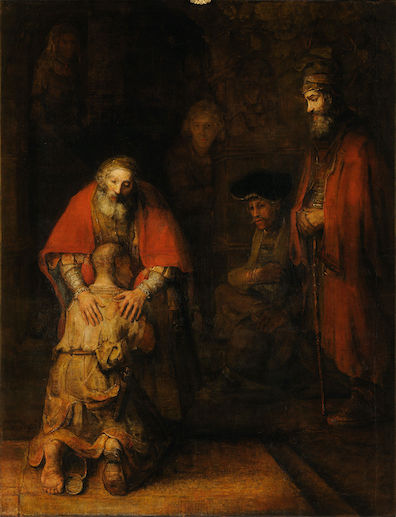Figure of speech. After finishing his tale of the
two old women on Nelson's pillar, Stephen is asked for a title
and offers two: "I call it A Pisgah Sight of Palestine or
The Parable of The Plums." Calling something a parable
will make most people think of the homely stories that Jesus
tells in the gospels, which appear to have derived from Hebrew
traditions. But the term originated in Greek rhetorical theory
as parabola, a brief story that illustrates some
particular point, usually a moral one. In this case
readers are obviously invited to speculate about what the
moral of Stephen's story may be.
Parabola (puh-RAB-uh-luh, from Greek para- = beside +
ballein = to throw) suggests "throwing together" two
unlike things, specifically an idea and a simple story that
illustrates it. Since parables have a didactic purpose, they
have much in common with fables, the difference being that
parables depict realistic human experiences. They also are
close kin to metaphor and simile
and to the narrative form that extended metaphors can take: allegory.
Roman rhetoricians, often using synonyms like similitude,
comparison, or exemplum, emphasized this metaphorical element.
The Rhetorica ad Herennium says that "Comparison is a
manner of speech that carries over an element of likeness from
one thing to a different thing. This is used to embellish or
prove or clarify or vivify."
Jesus tells parables to make a single instructive point, not
as allegorical narratives from which many different meanings
could be drawn. Rhetorical theorists advance the same view. In
The Elements of Rhetoric (1882), Canadian professor
James De Mille writes that "The parable may be defined as a
fictitious example designed to inculcate moral or religious
truth. It is similar to the allegory; and indeed it often
happens that it is difficult to assign some pieces with
certainty to the one or the other. There is, however, an
essential difference between them. The allegory sets forth a
story which shall impart moral instruction of a general
character; the parable is a story told for the sake of
illustrating some special point. The former is many-sided, the
latter is single in its aim; in the one the moral follows from
the narrative, in the other the narrative is made up expressly
for the sake of the moral; in the allegory the story itself is
full of interest, in the parable the moral quite overshadows
the story."
If Stephen's Parable of the Plums is indeed an
exemplum (with emphasis on the plum!), what instructive point
does he expect his listeners to take from it? Parables
typically do not explain their meaning, and Jesus's often feel
inscrutable. In Mark's gospel he implies that the obscurity is
deliberate, telling his disciples that "Unto you it is given
to know the mystery of the kingdom of God: but unto them that
are without, all these things are done in parables: / That
seeing they may see, and not perceive; and hearing they may
hear, and not understand; lest at any time they should be
converted, and their sins should be forgiven them" (4:11-12).
Some such stories, Jesus suggests, are intended to baffle
understanding, and Stephen's parable surely leaves many
readers feeling as baffled as the schoolboys in Nestor
feel after hearing his riddle. As he prepares to tell that
riddle, Stephen thinks of one of Jesus's sayings: "To Caesar
what is Caesar's, to God what is God's. A long look from dark
eyes, a riddling sentence to be woven and woven on the
church's looms." Jesus was a riddler, then, and so is Stephen.
The riddle is brief: two spinsters behave in a very
suggestive manner while gazing on the statue of a British
military hero. One might draw the depressing conclusion that
the women feel frisky in the presence of a foreign conqueror
because Irish people embrace their colonial subjection. But
exactly the opposite inference might also be drawn: by lifting up
their skirts and exposing themselves the women enact a
symbolic defiance of England and place a curse on its military
rule. If this reading is correct it explains why the parable
is linked with Moses's Pisgah sight of Palestine. Both titles
imply the liberation of Ireland from British rule.

